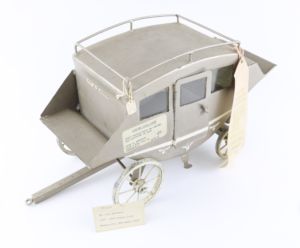August 22, 2018

This intricate model stage coach made of metal and fabric was entered into the State Fair Craft Show in 1971. According to the ribbon still attached to one side, it won 4th place. An adhesive label on the same side indicates this is a model of a Concord Stage Coach “first manufactured in Concord New Hampshire in 1827.”
The model was donated by Carl G. Anderson just after it showed in the State Fair, in 1971. Anderson noted on his HHM donation form that “Concord Stage Coaches were first manufactured in Concord, New Hampshire in 1827 and shipped to the west by sailing vessels from Portsmouth, New Hampshire down the south Atlantic, around the tip of South America, up the Pacific Ocean to San Diego, San Francisco and Seattle. These were the finest coaches made in America. They are still in use in western movies and the drivers today are as good as the drivers in the early days of the west.”
The Minnesota State Fair traces its roots to before the state itself. Territorial Fairs were held in Minnesota as early as 1854, and crafts have been a mainstay ever since then. The ancestor to the modern Creative Activities Department was the Women’s Work and Welfare Department. The early fair was largely targeted towards men, and this department arose as a place for women to congregate, socialize, and keep an eye on their children. Competitions in this department were dominated by quilts and other needlecraft, but baking and canning also became popular in the lead-up to the twentieth century.
The Women’s Work and Welfare Department (sometimes shortened to “Women’s Department”), as well as most of the fair, maintained a rural character before the twentieth century. The list of competitions was populated by practices like “darning and repair of napkins” and the making of log-cabin quilts, which by the 1890s were old and outdated. In 1902, Clara M. Luther was appointed superintendent of the department. She revised the competitions to introduce art forms popular in the growing urban landscape but were still absent from the state fair. These included things like basketry and miniature models, crafts more associated with professional arts and art schools.
With the modernization of the competitions at the turn of the century, another change was brought to the state fair. The shift away from the crafts of older generations meant that the individuals competing were now simply hobbyists in their craft. In the nineteenth century fairs, women submitting their artwork were often making quilts and clothing for their family already, as home-made objects were more of a necessity before the industrialization of the 1900s and 1910s. Creations on display were no longer fancified items of necessity, but pieces of art made by hobbyists in leisure-time.
These changes greatly impacted the overall “crafts show” of the state fair. By the 1920s, the State Fair Arts and Crafts Show was displaying very professional works of art. Paintings, drawings, sculptures, jewelry, metal and wood works were becoming more refined as the fair became urbanized and the organizers borrowed artwork from major museums like the Walker Art Center.
The 1910s through 1930s saw a dramatic increase in the number of men participating in Women’s Department competitions. Men submitting items were often those with a lot of free time on their hands: firemen, prison inmates, and the injured of WWI. The presence of men in this department increased over the decades and it became clear that this department was far from exclusively for women. The name of the department officially changed to the Home Activities Department in 1952.
The name of the department changed once again in 1971 to the Creative Activities Department, which remains the name today. While many things have changed about the nature of creative activities, some things have stayed the same. Canning, for example, is a time-honored tradition that you can still see at the fair this year. Other entries—a pocket watch chain made of hair, for example—have seen a sharp decline in popularity.
Why some practices still endure has everything to do with tradition. To this day, some of the most popular items on display have been with the fair from the very beginning. Attitudes on hobbies have changed creative activities too, and many trends and ideas have come and gone. The Creative Activities Department represents a microcosm of the State Fair itself. Both are monuments to traditions that connect us to our past while at the same time continually changing to reflect our present.
Author Bio:
Paul Schneider-Krumpus is a recent high school graduate and will be studying history at the University of Minnesota Twin Cities this fall. He does research and photography for Hennepin History Museum.
Sources and Further Reading:
https://www.mnstatefair.org/about-the-fair/history/
Blue Ribbon: A Social and Pictorial History of the Minnesota State Fair by Karal Ann Marling
Minnesota State Fair: An Illustrated History by Kathryn Strand Koutsky and Linda Koutsky
Minnesota State Fair, The History and Heritage of 100 Years by Ray P. Speer and Harry J. Frost
